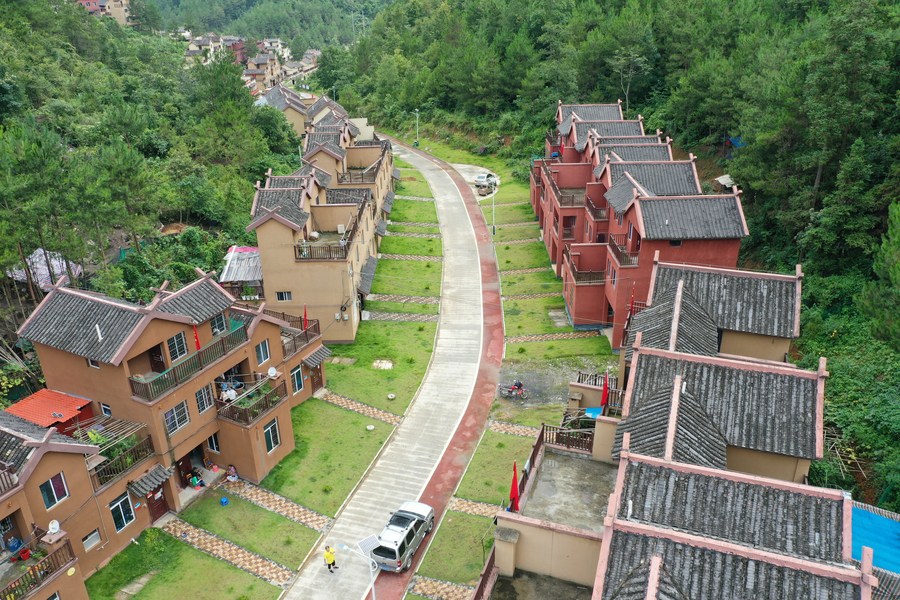Common Prosperity: China Is Committed to Building a Fairer Society

Seeking common prosperity will not lead to common poverty, but aims to build a fairer and more sustainable society.
President Xi Jinping at the 10th meeting of the CPC Central Committee for Financial and Economic Affairs held on August 17 stressed that “common prosperity is an essential requirement of socialism and a key feature of Chinese-style modernization.”
The meeting called for “expanding the proportion of middle-income groups, increasing the income of low-income groups, reasonably adjusting high incomes, outlawing illegal incomes, and forming an olive distribution structure with large middle and small ends.”
In fact, in the early years after the launch of the reform and opening-up policy, Deng Xiaoping put forward the concept of “common prosperity.” As he pointed out in 1985, “Getting rich together will one day become our core topic. Socialism is not about the wealthiness for the minority and poverty for the majority.” “Unlike capitalism, a distinctive feature of socialism is common prosperity without polarization.” He even warned, “Reform will fail if it leads to polarization.”
Deng believed that common prosperity should be achieved gradually, and it is necessary to remove the conventional economic straitjacket, to unleash and develop the productive potential. Therefore, he advocated letting some regions with viable conditions develop first and some people get rich earlier than others, and they would then help those that lagged behind to catch up, to eventually achieve common prosperity. After 40 years of reform and opening-up, China has become the world’s second-largest economy. In 2020, China’s GDP exceeded 100 trillion yuan ($15.53 trillion), but it has also caused income inequality among the people and a widening wealth gap.

Economic development should benefit all
China’s Gini coefficient jumped from 0.20 before reform and opening-up to 0.46 in 2020, crossing the internationally recognized “warning line” of 0.4. Many people who became rich in the early stage of reform and opening-up did not actively help the poor people and regions as expected. Instead, they bought wineries and enjoyed themselves overseas, or even emigrated to foreign countries with their wealth.
The income disparity brought about by reform and opening-up is reflected in the increasing concentration of wealth, the widening gap between urban and rural areas, and the imbalance of regional development.
According to the National Bureau of Statistics of China, the per capita disposable income of urban residents in China was 43,834 yuan ($6,807) in 2020, but that of rural residents was 17,131 yuan ($2,660), which was only about 40 percent of the per capita disposable income of the urban residents. In the same year, Beijing’s per capita GDP was about 164,909 yuan ($25,610), 4.6 times that of Gansu Province in northwest China, which had the lowest per capita GDP of 36,038 yuan ($5,597).
Economic development should not just merely pursue GDP growth, but should benefit all the people and take into account the fair distribution of wealth. Although income disparity is a common phenomenon in many countries, China, as a socialist country, should not have such a big gap between the rich and the poor. Severe disparity in income is a dangerous threat to social stability and will lead to social unrest in the long run.
The gap between urban and rural areas leads to uneven distribution of health services, housing and education, while the hukou system (registered permanent residency which binds to local social welfare) and imbalance regional development hinder national unity and result in a vicious cycle of social inequality.
Deng believed that socialism should, and could avoid the problem of the rich getting richer and the poor becoming poorer. “It is conceivable that by the end of this century when the level of moderate prosperity is reached, great emphasis should be placed on raising and resolving this problem,” he said prophetically in 1992.

Poverty reduction is the necessary route to achieve common prosperity. China has eliminated absolute poverty in 2020, laying the foundation for common prosperity. The original aspiration of the Communist Party of China (CPC) is to seek happiness for the people, not wealth for a few. Therefore, common prosperity is a reasonable extension of its policy after the country has eradicated absolute poverty and achieved a moderately prosperous society in all aspects. It is an inherent feature of socialism with Chinese characteristics.
The meeting also pointed out the necessity “to correctly handle the relationship between efficiency and fairness, construct a coordinated and supporting basic institutional arrangement composed of the primary distribution, redistribution and third distribution, intensify the adjusting ability of tax, social security and transfer payments and improve precision,” and “strengthen efforts to regulate and adjust high incomes, protect lawful incomes in accordance with the law and adjust excessively high incomes appropriately.” The meeting also encouraged high-income groups and enterprises to give more back to society by making third distribution through voluntary donations.
Revitalization of the rural areas, acceleration of urbanization, abolishment of the hukou system, providing equal education and training opportunities, preferential university entrance qualification for those living in rural and underdeveloped areas, popularization of modern technology and e-commerce, providing high-quality education and medical services to remote areas through the Internet and other administrative measures, will all help to reduce social injustice and narrow the wealth gap. Appropriate tax policies, such as raising the income tax for high earners, providing inclusive social security and levying estate duty, are also effective means of redistribution to reduce income disparity.
Recently, the Ministry of Education of China issued the “double reduction” policy to rectify off-campus tutorial market. It is stipulated that all existing tutorial organizations related to main subjects are to register as non-profit organizations and capitalization of such tutorial organizations is strictly prohibited. This policy reflects the adjustment of China’s population strategy. But more importantly, its main objective is to eliminate education inequality that has been exacerbated by rampant off-campus tutorial market.

Build a fairer and sustainable society
The Chinese government needs to strike a fine line in adjusting high income. The definition of high income cannot be one-size-fits-all as the cost of living varies in different cities and regions. Moreover, the pursuit of better and higher material life is an important impetus driving people’s enthusiasm. From a macro perspective, raising the income of low-income groups will be more effective than restraining excessively high income, in promoting common prosperity.
Recently, E-commerce giant Pinduoduo has pledged 10 billion yuan ($1.553 billion) to launch a “10-billion-yuan agricultural research project”, while Tencent and Alibaba have pledged 50 billion yuan ($7.765 billion) and 100 billion yuan ($15.53 billion) respectively to charity in response to the central government’s call.
While enterprises should give back to society, they also need profits and capital to sustain healthy growth. Therefore, donations to charity should come more from the personal wealth of the owners of the corporations, rather than from the corporations.
China’s regulation on Internet and technology giants is aimed at curbing the disorderly expansion and wild growth of capital, and creating a fairer and more reasonable competitive environment, rather than suppressing private enterprises or excluding capital. China’s economic growth depends on private enterprises and the domestic market. Reducing income disparity among the people and achieving common prosperity will help improve the overall consumption capacity of the people, expand domestic demand, and promote the dual-circulation economy.
Common prosperity is an important connotation of the CPC’s original aspiration to seek happiness for all people, and it is based on the premise of sustained economic growth. Although China’s GDP is already 70 percent of that of the US, its per capita GDP is only 16.5 percent of that of the US. Therefore, China’s economic growth potential is huge. Seeking common prosperity will not lead to common poverty, but build a fairer and more sustainable society.
The article reflects the author’s opinions, and not necessarily the views of China Focus.
Translated by Wu Ziqiong
Edited by Bai Shi
 Facebook
Facebook
 Twitter
Twitter
 Linkedin
Linkedin
 Google +
Google +







